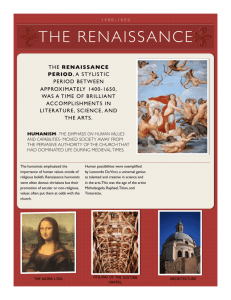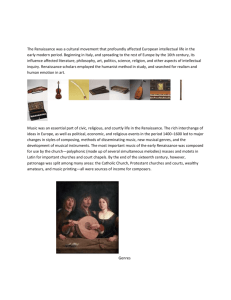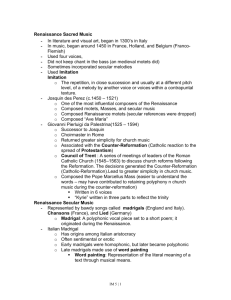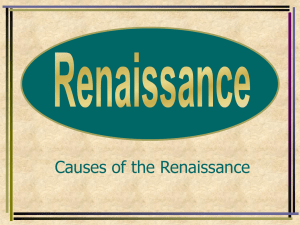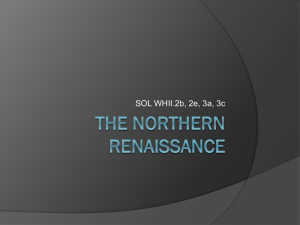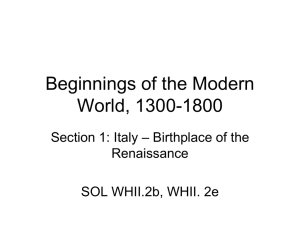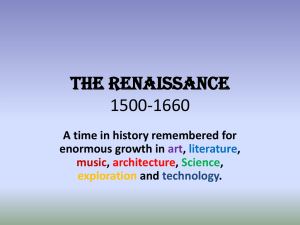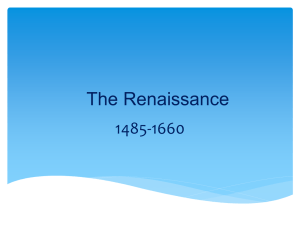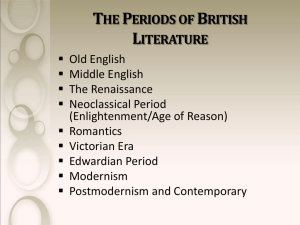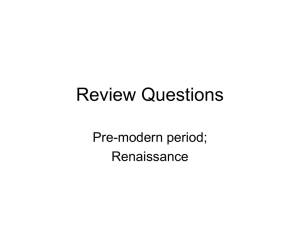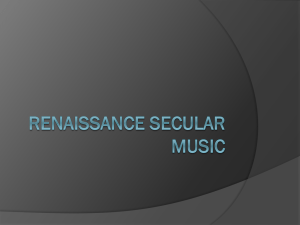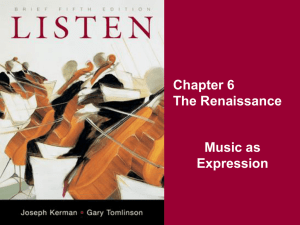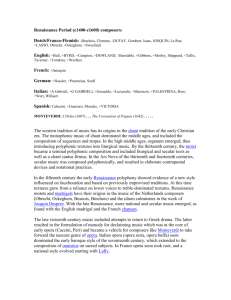The Renaissance Era - Kettering City School District
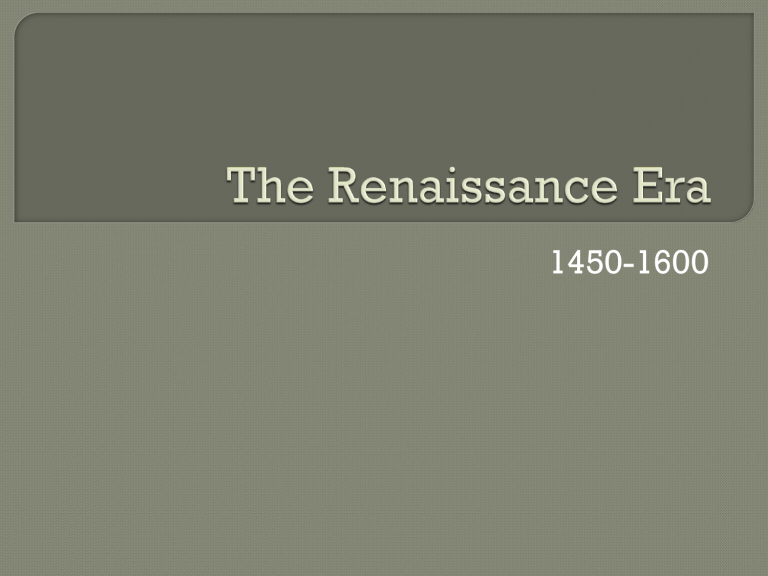
1450-1600
Leonardo da Vinci (1452-1519), painter/scientist.
Fall of Constantinople (1453)
Gutenberg Bible printed (1456) printing press.
Nicolas Copernicus (1473-1543), Polish astronomer.
Michelangelo (1475-1564) painter, sculptor
Martin Luther (1483-1546) religious reformer.
Columbus discovers the New World
(1492)
First music book printed in Italy (1501)
Council of Trent begins (1545)
Elizabeth I is crowned Queen of England
(1558)
William Shakespeare (1564-1616)
Musica Transalpina published (1588)
The Renaissance was an era of exploration, scientific inquiry, artistic awakening, and secularization.
Artists and writers found inspiration in the cultures of ancient Greece and Rome.
Renaissance musicians were employed in churches, cities, and courts; or in the trades of instrument building and music printing.
The name is misleading because it suggests a sudden rebirth of learning and art after a “stagnate” Middle Ages.
However it is a continuation.
It marks the passing of European society from a predominately religious orientation to a more secular one, and from an age of unquestioning faith and mysticism to one of reason and scientific inquiry.
The focus on human fulfillment rather than the hereafter; a new way of thinking centered on human issues and the individual.
People gained confidence in their ability to solve their own problems rather than rely exclusively on tradition or religion.
•
•
This “awakening” was called Humanism and was inspired by ancient cultures of
Greece and Rome.
Renaissance society embraced the ideas of ancient writers and philosophers, such as Plato and Virgil.
The revival of ancient writings mentioned earlier along with the introduction of printing (1455- Gutenberg), had its counterpart in architecture, painting and sculpture.
Lavish palaces and spacious villas were built according to harmonious proportions of the classical style.
The development of the compass made possible the voyages of discovery that opened up new worlds and demolished old superstitions.
Explorers were in search of a new trade route to the riches of China and the
Indies, instead they stumbled upon North and South America.
Nature entered painting as did a preoccupation with the laws of perspective and composition.
Medieval painting had presented life through symbolism; the Renaissance preferred realism.
Were supported by the chief institutions of their society-church, city, and state, as well as royal and aristocratic courts.
They found employment as choirmasters, singers, organists, instrumentalists, copyists, composers, teachers, instrument builders, and music printers.
Vocal forms of Renaissance music were marked by smoothly gliding melodies conceived especially for the voice.
The 16 th century has become known as the golden age of a cappella style.
Polyphony in this genre was based on the principle of imitation.
Most church music was written for a cappella performance. Why?
Secular music, however, was divided between purely vocal works and those in which the singers were supported by instruments.
The Renaissance also saw a growth of solo instrumental music, especially for the lute and keyboard.
Harmony came into play during the
Renaissance as composers leaned toward fuller chords.
They turned away from the open fifths and octaves to more “pleasing” thirds and sixths.
Word Painting- (making music reflect the meaning of the words)- was definitely favored in secular music.
Dissonance was used to describe or highlight the word “death”, while an ascending line was used to portray
“heaven” or the stars.
Polyphonic writing offered the composer many possibilities such as the use of a cantus firmus.
The preeminent composers of the early
Renaissance were from northern Europe, present day Belgium and northern
France.
In later Renaissance we will see the emergence of Italian composers in both the sacred and secular realms of music.
Mass sung in Latin, not vernacular
(language of the country)
Composers focused their polyphonic mass settings on the Mass Ordinary:
Kyrie, Gloria, Credo, Sanctus, Agnus Dei
Kyrie- is a prayer for mercy. Follows an A-
B-A form that consists on 9 invocations
Gloria- (Glory be to God on high), a joyful hymn of praise.
Credo- (I believe in one God, the Father
Almighty), this is the confession of faith and the longest of the Mass texts.
Sanctus (Holy, Holy, Holy), a song of praise which concludes with the
“Hosanna in the highest”
Agnus Dei (Lamb of God, Who takes away the sins of the world), sung 3 times.
Twice it concludes with “miserere nobis”
(have mercy on us) and on the 3 rd time with the prayer “dona nobis pacem” (grant us peace).
All 5 movements are part of the Ordinary or fixed portion.
Movements for special occasions (Proper) were added in between the Ordinary-see p.102
Early polyphonic settings of the Mass were based on fragments of Gregorian chant (cantus firmus)
It provided composers with a fixed element that they could embellish, using all the resources of their artistry, and when set in all the movements, it helped unify the Mass.
• Requiem: Mass for the Dead
Sung at funerals and memorial services
Opening verse: "Requiem aeternam dona eis,
Domine" (Grant them eternal rest, O Lord)
Part of the Burgundian School (Franco-
Flemish).
Music less complex than that of Ars nova
Many of his works are built on a cantus firmus
L'homme armé Mass, Kyrie
Popular secular tune is the cantus firmus (found in the tenor voice)
First part of the Mass Ordinary
Non-imitative polyphonic texture (four voices)
Ternary form
•
• Renaissance motet had a single Latin text
Majority of motets had a Marian (Virgin Mary) theme
• Typically motets were written for 3, 4, or more voices
• Sometimes motets were based on a cantus firmus
Josquin des Prez of Northern France was considered one of the greatest Renaissance motet composers.
• Franco-Flemish composer, made career in Italy
Milan: Court of Cardinal Ascanio Sforza
Ferrara: Court of Ercole d'Este
Rome: papal choir
Humanism evident in his music (emotion over intellect).
Composed sacred and secular music.
Protestant revolt led by Martin Luther (1483–1546):
Reformation
• Catholic response: Counter-Reformation (1530s–
1590s)
Council of Trent attendees sought to reform Catholic
Church
Concerns of Council of Trent
Corruption of chant by embellishment
Use of certain instruments in religious services
Incorporation of popular music in Masses
Secularism of music
Irreverent attitude of church musicians
Committee recommended a pure vocal style that respected the integrity of the sacred texts
Italian composer, organist, choirmaster.
Director of the Sistine Chapel Choir (Pope
Julius III).
Wrote mostly sacred music.
Pope Marcellus Mass met the new strict demands of the
Council of Trent.
Probably performed a cappella
Written for 6 voice parts:
Soprano (sung by boys or male falsettos)
Alto (sung by male altos or countertenors)
Tenor I
Tenor II
Bass I
Bass II
In the Renaissance Era
The Renaissance saw a rise in amateur music-making and in secular music
(French chansons and the Italian and
English madrigals).
Instrumental dance music was played by professional and amateur musicians, who often added embellishments.
The madrigal originated in Italy as a form of aristocratic entertainment.
Monteverdi was a master of the Italian madrigal and of expressive devices such as word painting.
The English madrigal was often simpler and lighter in style than its Italian counterpart.
Professional musicians entertained in courts and at civic functions.
Merchant class amateurs played and sang at home.
Most popular instruments: lute, keyboard instruments.
A well-bred young woman was expected to have studied music.
Some women achieved great fame as professional singers.
Main Music genres: chanson and madrigal
Major literary influences:
Francesco Petrarch (1304–1373) “Father of Humanism”
Pierre de Ronsard (1524–1585) “Prince of Poets”
Favored vocal genre in Burgundy and
France in the 15th century.
Usually for 3 or 4 voices.
Set to courtly love verses.
Freer poetic structures (without set repetition patterns).
Premier composers: Guillaume Du Fay, and Josquin des Prez.
Written during the last year of the composer's life.
Four-voice texture.
Language of courtly love.
Pain and suffering of leaving one's beloved.
Uses an archaic sounding church mode (E)
Varied texture: homorhythm, imitation.
Expressive text setting, using word painting.
16th century was a period of growth for instrumental music.
Published music was readily available.
Publishing centers: Venice, Paris,
Antwerp.
Instrumentation was unspecified.
The occasion dictated the ensemble:
(indoor or outdoor).
Pavane: stately court dance.
Saltarello: quicker Italian jumping dance.
Galliard: more vigorous French version of saltarello.
Allemande: German dance in moderate duple time.
Ronde: less courtly round dance, danced in a circle outdoors.
Chief form of Renaissance secular music.
Song form flourished at the Italian courts.
Text: short poem of lyric or reflective nature.
Includes "loaded" words: weeping, sighing, trembling, dying, etc.
Music: sets text expressively.
Instruments double or substitute for the voices.
Three phases of the madrigal:
First phase (c. 1525–1550)
Entertaining for the performers (often amateurs).
Second phase (c. 1550–1580):
Art form in which music and words were clearly linked.
Third phase (c. 1580–1620):
Exhibited chromatic harmony.
Dramatic declamation and vocal virtuosity.
Vividly described emotion.
Extended beyond the Renaissance into the
Baroque Era.
Composers in England further developed the Italian madrigal.
English madrigalists included:
Thomas Morley, Thomas Weelkes, John
Farmer.
First collection of Italian madrigals published in England entitled.
Musica transalpina (Music from beyond the
Alps) 1588.
English madrigals were often simpler and lighter in style than Italian.
New English madrigals were soon cultivated, some with refrain syllables ("fa la la").
